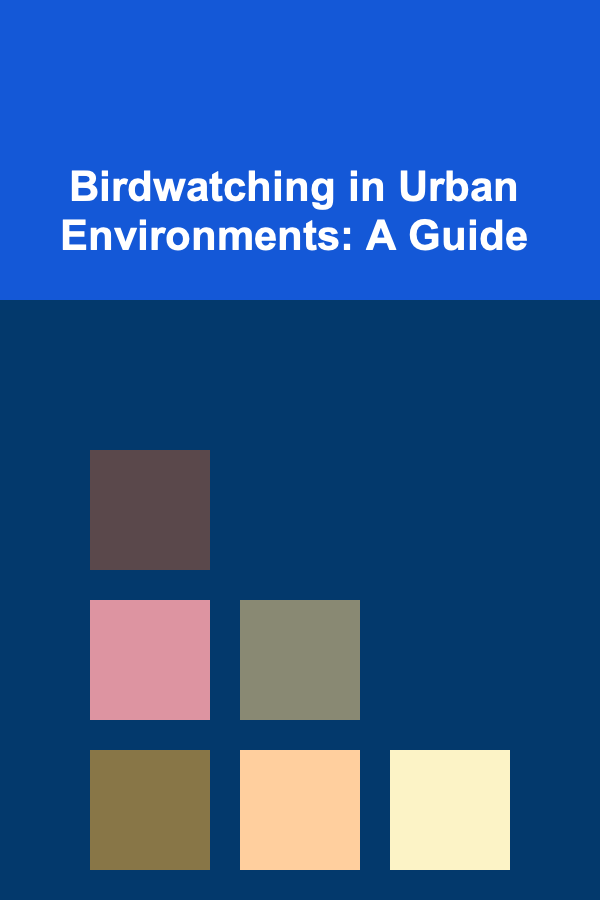
Birdwatching in Urban Environments: A Guide
ebook include PDF & Audio bundle (Micro Guide)
$12.99$9.99
Limited Time Offer! Order within the next:

Birdwatching is often thought of as a rural or wilderness activity, typically associated with peaceful nature reserves or far-flung hiking trails. However, urban environments are increasingly becoming prime locations for birdwatching enthusiasts, offering both accessibility and a surprising variety of species. Cities, despite their concrete jungles, provide diverse ecosystems that attract a wide array of bird species, from common backyard varieties to rare migratory visitors.
In this guide, we will explore the benefits of birdwatching in urban settings, the types of birds you might encounter, strategies for successful birdwatching in cities, and tips on how to make the most of your birdwatching experience in an urban environment.
Why Birdwatching in Urban Environments Matters
Urban birdwatching is more than just a hobby; it offers several significant benefits both for birdwatchers and for the broader ecosystem.
1.1. Access to Nature
Urbanization can often lead to a disconnect from nature. Birdwatching provides city dwellers with an easy way to reconnect with the natural world, even within the confines of the concrete jungle. Public parks, green spaces, and even balcony gardens can serve as small oases, offering an escape from the bustle of daily life.
1.2. Conservation Awareness
Many urban birds face unique challenges, including habitat loss, pollution, and climate change. By observing and documenting urban birdlife, birdwatchers can raise awareness about conservation efforts needed to protect these species. This, in turn, can lead to better habitat management and policies aimed at preserving urban biodiversity.
1.3. Health Benefits
Spending time outdoors observing birds can have a calming effect on the mind, reducing stress and anxiety. Studies have shown that birdwatching is a meditative activity that helps improve mental health, providing benefits similar to mindfulness practices.
1.4. Increased Biodiversity Awareness
Urban birdwatching can also help foster an understanding of biodiversity in cities. Many birds rely on city parks, green rooftops, and even abandoned lots for food and shelter, contributing to a diverse urban ecosystem. As birdwatchers, individuals can observe how urban planning and landscaping affect bird populations, thus becoming more conscious of how human activity influences the natural world.
Types of Birds in Urban Environments
While birdwatching in cities can differ from rural settings, urban areas still host a rich diversity of birds. Here are some common types of birds you might encounter:
2.1. Common Urban Birds
Many species thrive in cities, adapting to human-dominated environments. These birds are often abundant in urban parks, gardens, and street trees.
- Pigeons: One of the most common birds in cities worldwide, pigeons are highly adaptable to urban environments. They are often found in public spaces, perched on buildings or foraging for food.
- Sparrows: House sparrows are a quintessential city bird, commonly found in parks, alleyways, and near human habitation. They are social and often seen in small flocks.
- Crows: Known for their intelligence, crows are frequently seen in cities. They can adapt to a variety of habitats, from parks to urban streets, and are often seen foraging for food scraps.
- Starlings: European starlings are known for their iridescent plumage and their tendency to form large flocks. They often roost in urban areas, especially in trees, lamp posts, and even building crevices.
- Robins: These familiar birds are often found in urban gardens and parks. They are attracted to areas with plenty of insect life and are frequently seen hopping along the ground searching for food.
2.2. Migratory Birds
Urban areas also serve as stopover points for migratory birds on their way to breeding grounds or warmer climates. These birds provide opportunities for birdwatchers to spot species that might otherwise be elusive.
- Warblers: Small, often brightly colored songbirds, warblers pass through urban areas during migration. They are usually found in wooded areas or parks with dense vegetation.
- Swallows: Swallows are often seen swooping through the air above cities, feeding on insects. They are common in the late spring and summer months.
- Canada Geese: These large waterfowl often migrate through urban areas, stopping at lakes, rivers, or city parks. Their distinctive honk and large size make them easy to identify.
2.3. Raptors in the City
Even birds of prey, typically associated with rural and mountainous areas, are becoming a common sight in cities. Raptors such as hawks, kestrels, and falcons can often be found perched on tall buildings or hunting in city parks.
- Peregrine Falcons: Known for their incredible speed, peregrine falcons have made a successful comeback in many cities. They nest on tall buildings, hunting pigeons and other birds.
- Red-tailed Hawks: Red-tailed hawks can be seen soaring above urban areas, often perched on light posts or trees, hunting small mammals and birds.
How to Get Started with Urban Birdwatching
Birdwatching in an urban environment doesn't require a lot of specialized equipment or extensive travel. With the right approach, anyone can get started with birdwatching in their city. Here are some essential steps to help you begin:
3.1. Choosing the Right Location
The key to successful birdwatching is choosing a location that attracts birds. While most urban environments have green spaces, not all are equally productive for birdwatching. Consider the following locations:
- City Parks: Parks are great places to start, as they often contain a variety of trees, bushes, and open spaces that attract birds. Look for parks with ponds, lakes, or rivers, as water attracts both birds and insects.
- Rooftop Gardens: Many cities have rooftop gardens or green spaces that provide birds with food and shelter. These are often quieter, less crowded areas that can offer unique opportunities for birdwatching.
- Street Trees and Gardens: Urban trees and home gardens can be hotspots for local birdlife. Observing birds in smaller, more intimate settings allows for closer and more detailed viewing.
- Urban Wetlands: If your city is near a river or lake, there may be wetlands that support waterfowl, shorebirds, and wading birds. These areas can be especially rich in biodiversity.
3.2. Equip Yourself
While birdwatching in an urban environment doesn't require professional gear, having a few key items will enhance your experience.
- Binoculars: A pair of binoculars allows you to observe birds from a distance without disturbing them. Opt for compact binoculars if you plan to carry them around the city.
- Field Guide: A field guide to birds will help you identify different species. Many guides are available in app form, providing access to photos, calls, and other identification tools.
- Notebook or Birdwatching App: Keeping a journal of your sightings can help you track the birds you observe. Alternatively, use a birdwatching app that allows you to log your sightings and learn more about different species.
3.3. Be Patient and Observant
Birdwatching requires patience. Birds are often shy and may not immediately appear when you arrive. To increase your chances of success:
- Be Quiet: Birds are sensitive to noise. Try to move slowly and quietly, avoiding sudden movements that might scare them away.
- Look for Patterns: Birds often follow routines. They may visit the same spots at the same time each day, so keep an eye on where and when you've seen birds before.
- Observe the Environment: Pay attention to the types of plants and trees in the area. Birds are often attracted to certain flowers, shrubs, and trees that provide shelter and food.
3.4. Respect the Birds and Their Habitat
While birdwatching in urban environments, it's important to respect the birds and their surroundings. Avoid disturbing their nests or habitats, and don't get too close to the birds. Always follow local regulations regarding wildlife protection.
Challenges of Urban Birdwatching
Urban birdwatching does come with its set of challenges. Understanding these challenges can help birdwatchers make the most of their experience.
4.1. Noise and Pollution
One of the major drawbacks of birdwatching in cities is the constant noise from traffic, construction, and human activity. Noise pollution can affect the behavior of birds, making them more elusive or leading them to change their habits.
4.2. Limited Green Spaces
Many cities suffer from a lack of green spaces, which means fewer areas for birds to thrive. Urban sprawl and overdevelopment can lead to habitat loss, forcing birds to migrate or find new places to live.
4.3. Bird Strikes
Tall buildings with large windows are a danger to urban birds, as many birds do not see glass and often collide with it. Birdwatchers can play a role in advocating for bird-friendly building designs and safer environments for birds.
Conclusion
Birdwatching in urban environments offers a unique opportunity to connect with nature in the heart of bustling cities. By understanding the types of birds in urban areas, learning where to look, and equipping yourself with the right tools, you can enjoy a fulfilling and rewarding birdwatching experience. In addition, urban birdwatching raises awareness about the importance of conservation and the role cities can play in protecting bird species. So, whether you're in a park, on a rooftop, or simply observing birds in your neighborhood, there is always a birdwatching adventure waiting in your city.
Reading More From Our Other Websites
- [Home Space Saving 101] How to Incorporate Smart Technology for Space-Saving Solutions
- [Personal Investment 101] Building a Passive Income Stream Using Deep Learning Models
- [Personal Finance Management 101] How to Master Cutting Unnecessary Expenses Without Sacrificing Your Lifestyle
- [Personal Investment 101] How to Invest in Sustainable Energy and Green Technologies
- [Organization Tip 101] How to Design a Multi-Sensory Room for Stress Relief and Relaxation
- [Personal Care Tips 101] How to Use Moisturizer to Soothe Sunburned Skin
- [Home Security 101] How to Install a Video Doorbell for Added Home Protection
- [Digital Decluttering Tip 101] Top 10 Cloud Tools to Keep Your Projects Organized and Collaborative
- [Personal Care Tips 101] How to Make Your Blush Pop Without Looking Overdone
- [Hiking with Kids Tip 101] How to Rate Hiking Paths for Kids: A Practical Guide for Parents

How to Create a Bookkeeping Checklist for Small Business Owners
Read More
How to Renovate Your Home to Create a Relaxing Atmosphere
Read More
How To Start Competitive Surfing
Read More
How to Develop Your Cognitive Flexibility
Read More
How To Grow Your Own Spices: A Comprehensive Guide
Read More
10 Tips for Aspiring Astrophysicists
Read MoreOther Products

How to Create a Bookkeeping Checklist for Small Business Owners
Read More
How to Renovate Your Home to Create a Relaxing Atmosphere
Read More
How To Start Competitive Surfing
Read More
How to Develop Your Cognitive Flexibility
Read More
How To Grow Your Own Spices: A Comprehensive Guide
Read More